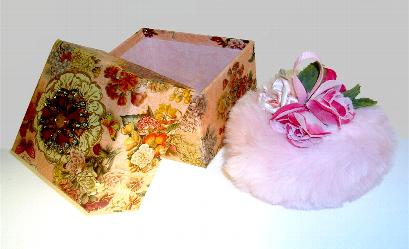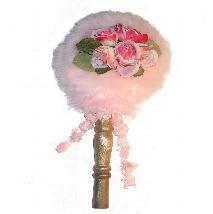Soft, plush fur makes a very luxurious puff to distribute powder perfectly. Generously sized, washable, and very attractive. Very feminine, Plain puffs available for the discriminating or theater professional and make up artist. Popular for applying shimmer powders, talcs or constarch. No order too big or small.

Powder puffs are pieces of soft material used for the application of various types of loose powder, body shimmer or talcum powder. Powder puffs are the tool of choice when it comes to applying loose powder, especially if you're covering a larger area.
Dip a powder puff in shimmering body powder and dust lightly all over. If you're feeling adventurous, you can highlight you cleavage by dusting shimmering powder underneath a low-cut blouse.
Apply powder on the go with a puff on a stick. Powder is stored inside the puff and is released when you apply pressure. Sweep your wand for a light coat, tap it to release a little extra and swat it to realease even more. Make sure to keep it in a clean, dry area in your purse or overnight bag. Look for stick puffs filled with shimmering powder for day into night use, or foundation powder for daily touch-ups. Take a hot shower and towel dry. Use a large, cotton powder puff to apply talcum powder.
Historically, powder puffs have been made of very fine down feathers, cotton, fine fleece, etc. In modern times synthetic materials such as velour or fur are used for powder puffs.
In addition to softness, an important characteristic of powder puffs is their intake ability, i.e., the ability to hold powder. It was reported that for synthetic fibers important factors in designing high-intake powder puffs are mostly geometric ones: fiber diameter, pile length, and space between fibers, with little dependence on material factors.[1]
Powder puffs have been used as a stereotype image for soft, careless femininity, as seen, e.g., in the term "Powder Puff sports," including collegiate sorority flag football leagues. The name of the Powerpuff Girls is a pun with word "powderpuff".
Talc
Talc (derived from the Persian via Arabic talq) is a mineral composed of hydrated magnesium silicate with the chemical formula H2Mg3(SiO3)4 or Mg3Si4O10(OH)2. In loose form, it is the widely used substance known astalcum powder. It occurs as foliated to fibrous masses, its monoclinic crystals being so rare as to be almost unknown. It has a perfect basal cleavage, and the folia are non-elastic, although slightly flexible. It is sectile and very soft, with a hardness of 1 (Talc is the softest of the Mohs' scale of mineral hardness, and can be easily scratched by a fingernail). It has a specific gravity of 2.5–2.8, a clear or dusty luster, and is translucent to opaque. Talc is not soluble in water, but it is slightly soluble in dilute mineral acids. Its colour ranges fromwhite to grey or green and it has a distinctly greasy feel. Its streak is white.
Talc is an important industrial mineral. Its resistance to heat, electricity and acids make it an ideal surface for lab counter tops and electrical switchboards. It is also an important filler material for paints, rubber and insecticides. Even with all these uses, most people only know talc as the primary ingredient in talcum powder. Mineral specimens are not very common as it does not form very large crystals. However, it often replaces other minerals on an atom by atom basis and forms what are called pseudomorphs (false shape). The talc takes the form of the mineral it replaces. A specimen of what looks like milky quartz is quite a suprise when it not only has a soapy feel but can be scratched by a fingernail.
PHYSICAL CHARACTERISTICS:
• Color is green, gray and white to almost silver.
• Luster is dull to pearly or greasy.
• Transparency crystals are translucent and masses are opaque.
• Crystal System is monoclinic; 2/m.
• Crystal Habits: never in large individual crystals, but if found are flattened tabular crystals with a hexagonal cross-section, usually talc is found in compact or lamellar masses. Forms pseudomorphs (false shape) of other crystals such as quartz, pyroxenes, olivine and amphiboles.
• Cleavage is perfect in one direction, basal.
• Fracture is uneven to lamellar.
• Hardness is 1 (can leave mark on paper)
• Specific Gravity is 2.7 - 2.8 (average)
• Streak is white.
• Other Characteristics: cleavage flakes are slightly flexible but not elastic and talc has a soapy feel to the touch.
• Associated Minerals include serpentine, dolomite, magnesite, quartz, pyroxenes, olivine, biotite andamphiboles.
• Notable Occurances: include many mines up and down the Appalachian Mountains and in California and Texas, USA; Germany; Florence, Italy; Tyrol, Austria; Transvaal, South Africa and Shetland, Scotland.
• Best Field Indicators softness, color, soapy feel, luster and cleavage.
Cornstarch
(Redirected from Corn starch)
Products treated with cornstarch
Cornstarch, or cornflour, is the starch of the corn (maize) grain. It is also grown from the endosperm, or white heart, of the corn kernel. It has a distinctive appearance and feel when mixed raw with water or milk, giving easily to gentle pressure but resisting sudden pressure (see Non-Newtonian fluid). It is usually included as an anti-caking agent in powdered sugar (10X or confectioner's sugar). For this reason, recipes calling for powdered sugar often call for at least light cooking to remove the raw cornstarch taste.
[edit]Manufacture
The corn is steeped for 30 to 48 hours, which ferments it a little. The germ is separated from the endosperm and those two components are ground separately (still soaked). Next the starch is removed from each by washing. It is separated from the gluten and other substances, mostly in hydrocyclones and centrifuges, and dried. (The residue from every stage is used in animal feed and other products.) Finally the starch may be modified for specific purposes.[1]
Cornstarch is a silky powdery starch made from corn. In Britian, it is sometimes referred to as Corn Flour. Use cornstarch in body powders, cosmetics, milk baths and bath bombs to add silkiness and to soothe the skin. Cornstarch is a safer alternative than using talc on babies. It can be added to diaper area barrier creams to keep the skin dry and protected from moisture.
